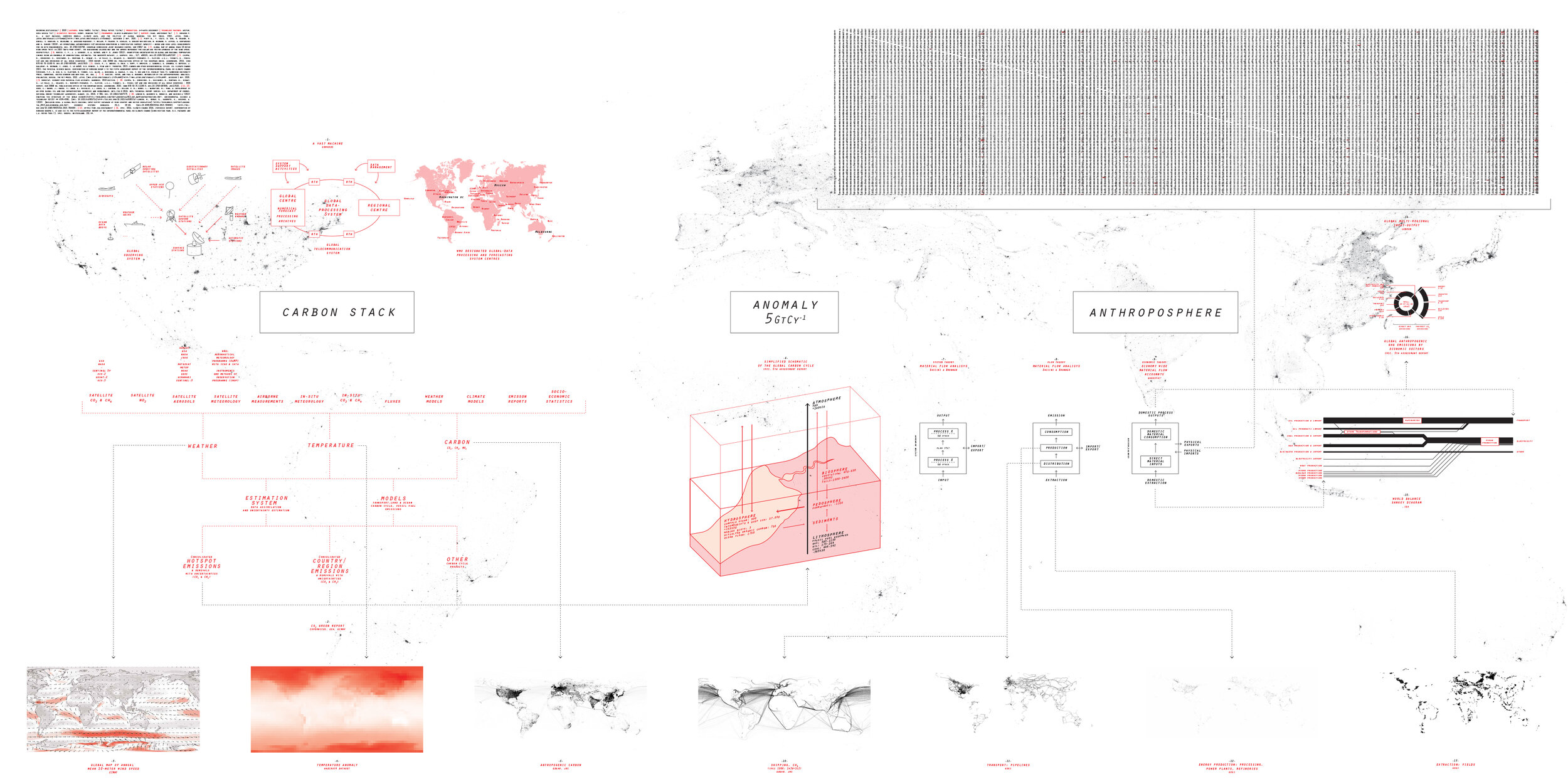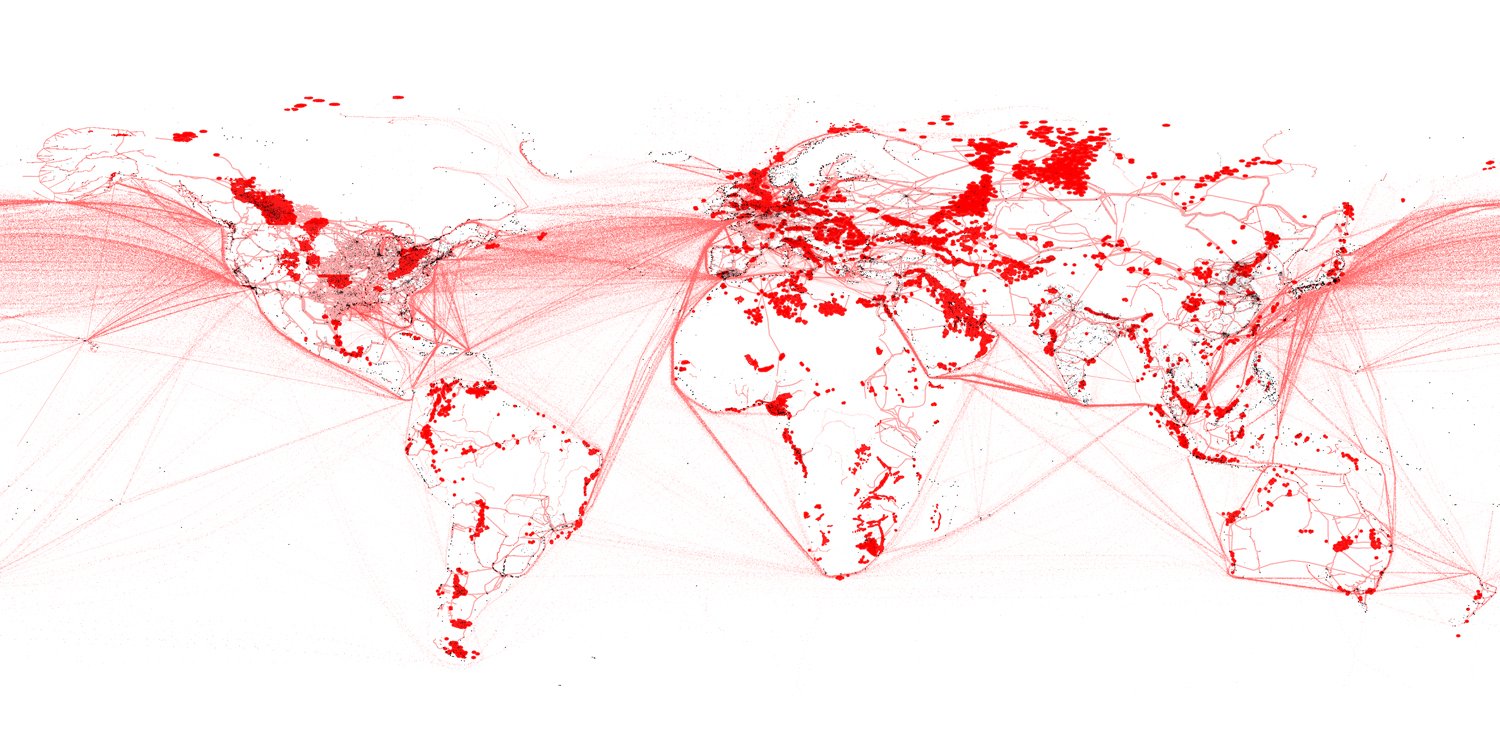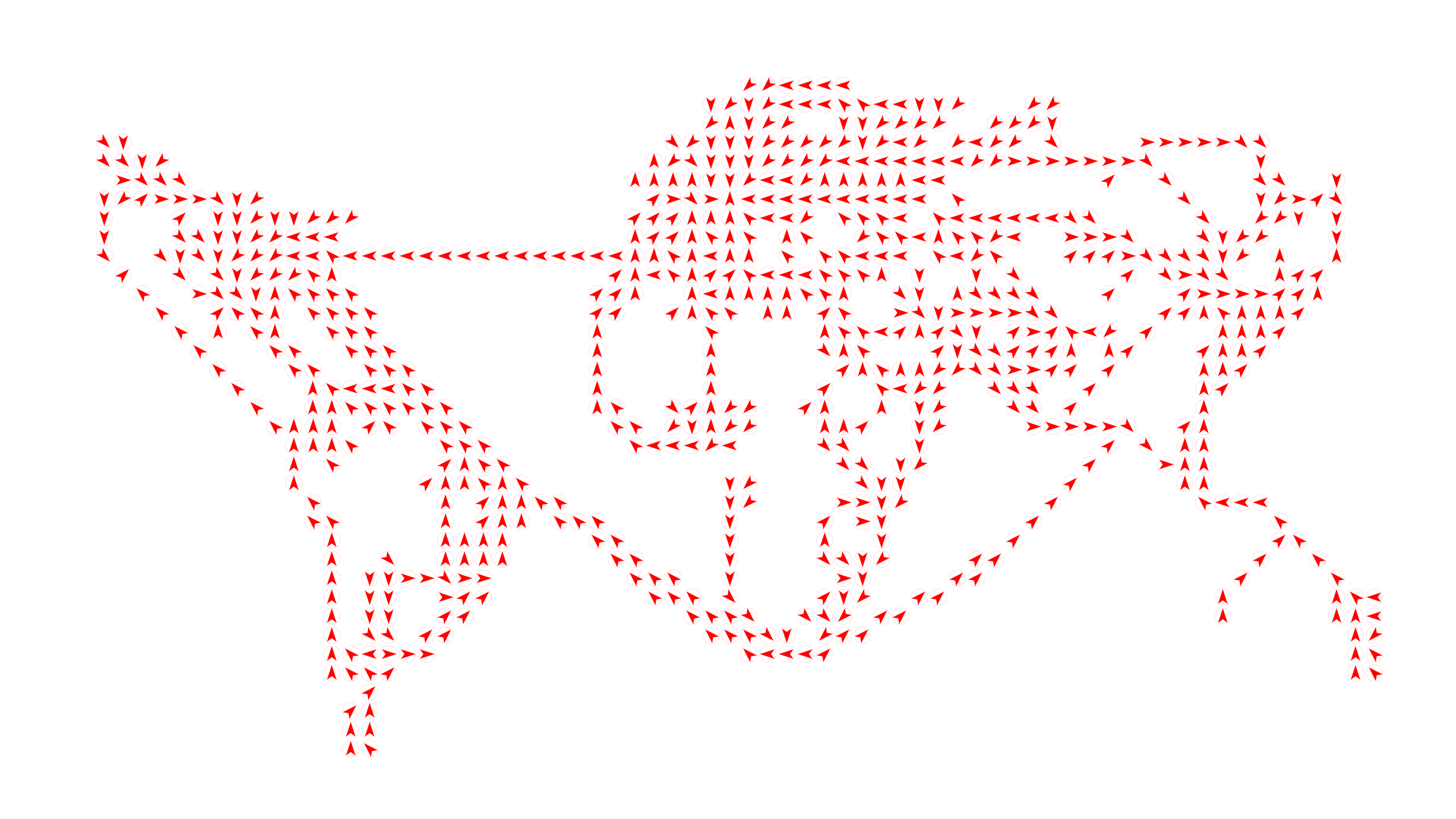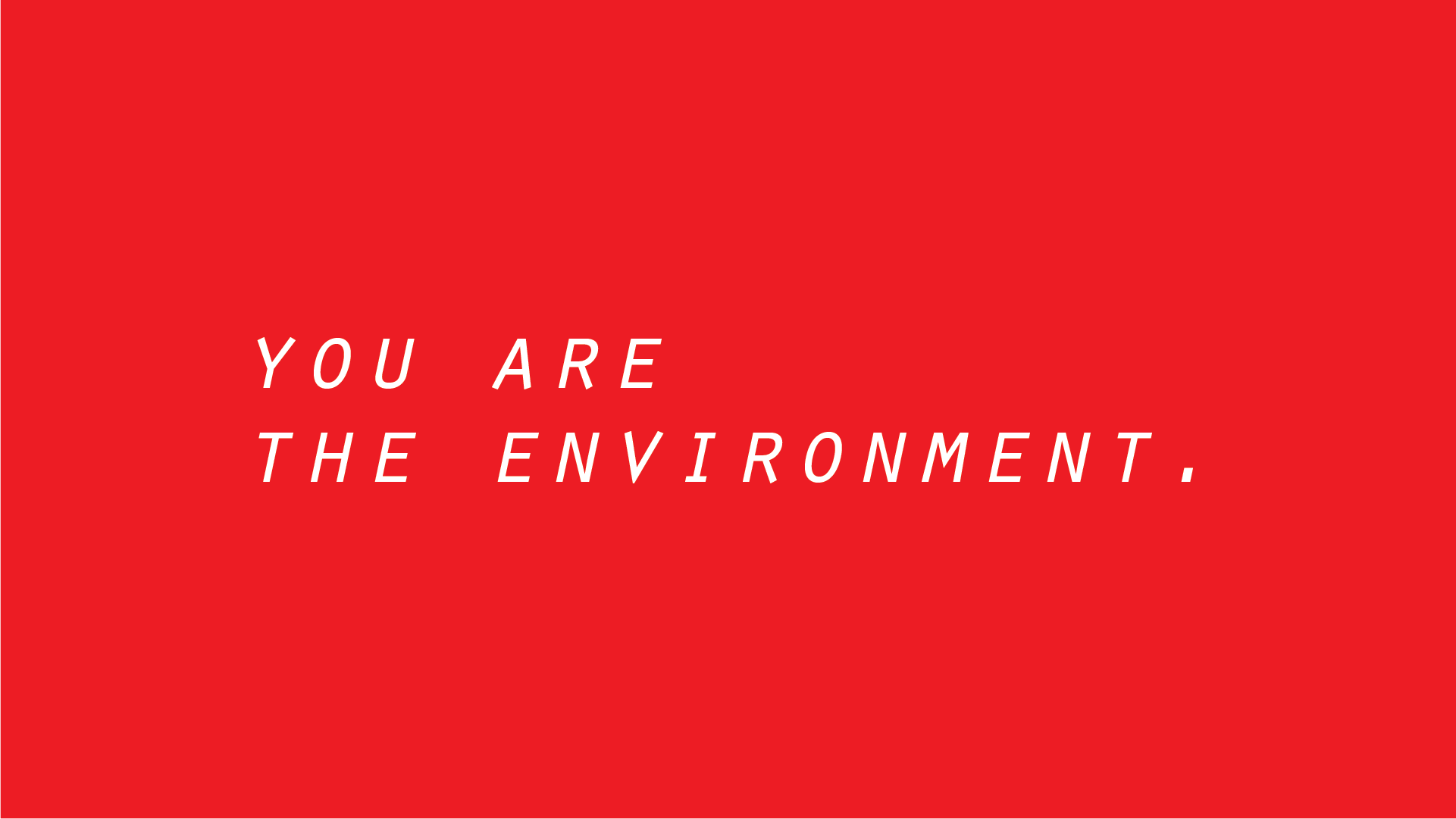becoming.eco(logical)
Becoming.eco(logical) │ 2020 │ Miha Turšič and Špela Petrič │ Production: S+T+ARTS residency │ Technology partner: Arctur, Nova Gorica │ Science partner: CHE project, ECMWF, Reading │ Programmer: Slavko Glamočanin │ Support: Waag, Amsterdam │ Acknowledgment: Tristan Pahor and Gianpaolo Balsamo.
While society is putting enormous efforts into an understanding of the time and space we live in, the becoming.eco(logical) project explores human exceptionalism by tracing the substance flow of one of the most abundant elements in the Earth’s crust—and in the universe—carbon. Observing the way carbon enters, flows, stocks and exits human society helps us understand ways humans relate to the environment on a fundamental material level. Most of the carbon exchange in the Earth system happens between the biosphere, the atmosphere and the hydrosphere with a balanced annual cycle influenced by seasonal conditions. However, the main deposits of carbon are in the lithosphere, deep under the Earth’s surface. Before the Industrial Revolution, the only flow of carbon between the lithosphere and the rest of geospheres was through the volcanic eruptions. Through the last hundred years, appropriation of lithospheric carbon stock as an energy resource increased the flow of carbon from the lithosphere to the atmosphere to more than 5 gigatons of carbon per year. No other biotic or abiotic process can compare with such an extensive impact.
What we argue with becoming.eco(logical) is that the nature of human carbon flows is so uncharacteristic for any existing geospheres that it composes a new geosphere—the Anthroposphere. What these carbon flows also reveal is that these flows primarily represent private interests, and are in stark opposition to environmental and societal concerns. In this way, it becomes clear who constitutes the Anthropos and who belongs to the environment.
The becoming.eco(logical) project depicts the flow of carbon through the Anthroposphere. Through the understanding of the carbon stack, a vast socio-technological computational machine is required to observe the planet’s carbon on a global scale, to collect acquired data, develop models and generate global environmental forecasts. As climate science holds on to a traditional structuring of the environment through Earth sub-systems, it seems to prevent a detailed analysis of human activity that would benefit from cross-disciplinary synthesis and from the scientifically uncomfortable position where the observer is at the same time also the subject of study. In such a context, climate science identifies humans only as an environmental anomaly.
becoming.eco(logical) demonstrates an attempt to overcome this human-blindness through the exploration of the ways in which carbon enters, flows, stocks, and exits human society. We were able to identify the very distinct nature of human carbon flows, where lithospheric carbon is appropriated for energy production and released into the atmosphere. This feature of the new Earth sub-system—the Anthroposphere—in scope and scale so significant and characteristic of human intervention, is presented as the carbon substance flow projected onto the Global Urban Footprint[1] map.
With the introduction of the Anthroposphere, we also address different ways of knowledge production. Matters of fact provide the foundations for the understanding of the environment, despite often excluding or avoiding the representation of human agency within it. On the other hand, matters of interest represent a very straightforward agency that seeks power and control over the environment so it can benefit on account of the environment as a resource. Consequently, matters of concern represent this same environment under the impact of those interests while exposing urgencies and controversies emerging from its use. Furthermore, matters of care stem from an understanding of the interdependence of actors within the environment and rather than trying to benefit single actors focus on cultivating the relations between them.
In this context, becoming.eco(logical) develops computational images depicting not the sterilized cloudless Earth, but the causality between ways of mattering with an ambition to affect the spectators to become environmental. If we seek to become ecological, we need to become the environment.
Methodologically, the becoming.eco(logical) is a composite of several critical media, art-science and industrial ecology methodologies.
For the analysis of the existing techno-scientific environmental images, we used a combination of two concepts: the stack[2] by Benjamin Bratton and a vast machine[3] by Paul N. Edwards. Through their dissection of the large computational infrastructure required for the climate science, we were able to analyze three iconic climate images: The Stripes[4] by Ed Hawkins, the simplified schematic of the carbon cycle[5] by IPCC and the CHE Tier 1 nature run[6] by ECMWF.
The main outcome of this analysis was an environmental understanding of humanity as an Earth system anomaly, guiding us to the need to update the existing Earth system with additional sub-system, distinct by its carbon flows, the Anthroposphere. For the understanding of the ways carbon enters, flows, stocks and exits human society we used the material and substance flow analysis method[6] by Baccini and Benner, and energy balancedisplayed through the Sankey diagram by IEA[7].
To develop a narrative, we used the dialogue between ways of mattering, formulated in the field of science technology studies by Latour[8] and de la Bellacasa[9]. In this way, we were able to address the epistemological and ontological understanding of relations between humans and the environment.
The main challenge of the becoming.eco(logical) residency was to understand the specificity of climate images, the way they depict understanding of the environment, us humans, and the relations between both. We approached this challenge in official partnership with Arctur supercomputer center in Nova Gorica, Slovenia, and an unofficial one with the CHE Horizon project coordinated by ECMWF in Reading, UK.
We started the co-creation effort with the assumption that climate images are the product of scientific method and knowledge production infrastructure. However, early into the residency, during the visit at the ECMWF[1] we learned that climate science recognizes human impact on the environment mainly as an environmental anomaly and that there are no off-the-shelf models that would help us portray humanity within the environmental observations.
What followed was an intense exploration into the controversies of environmental sciences and humanities, researching ways of understanding the challenge. Also, due to the lack of existing models, we explored the availability of accessible data sets, and on the way learning how such data can be used, and also learning tools like QGIS.
Within these efforts, we also identified the gap between capacities provided by tech partner Arctur, that offered us the use of their supercomputing platform, and the tools, models and datasets we needed. While Arctur provided infrastructure, our scientific partner didn’t have the tools with which we could work with. So, although we expected to develop an artwork as a TRL5 prototype, we needed to step back to the reformulation of the concept on a level of TRL2 with an ambition to reach proof-of-concept at the TRL3.
In the following steps, we started engaging programmer and computer system wizard Slavko Glamočanin, with whom we started developing a custom platform for data normalization and visualization. Within this effort, we managed to normalize ten different datasets in a way we were able to demonstrate first data narratives. The outcome of these efforts is the becoming.eco(logical) platform, short BEL platform, that enables us to observe a variety of environmental and socio-economic datasets and compare different data narratives. In the current version, different global gridded datasets were converted to the BEL format in 4K resolution. Each data point is associated with information of population density, carbon production, consumption, import/export, carbon emissions, transport, visual color as seen without clouds, biodiversity index and biomass index. We developed converters from GeoTIFF, NetCDF, Shapefiles and latitude-longitude comma-separated values formats to the BEL format, as well as the projector of the country level socio-economic data to the population layer of the BEL format and by necessity also converter between different coordinate reference systems.
For the carbon flow visualization, we used the following datasets:
Satellite lowres raster tiles; OpenMapTiles 2020.
Tim Newbold; Lawrence N Hudson; Andrew P Arnell; Sara Contu et al. (2016). Dataset: Global map of the Biodiversity Intactness Index, from Newbold et al. (2016) Science. Natural History Museum Data Portal (data.nhm.ac.uk). https://doi.org/10.5519/0009936
Santoro, M. et al. (2018): GlobBiomass - global datasets of forest biomass. PANGAEA, https://doi.org/10.1594/PANGAEA.894711.
Source: European Commission, Joint Research Centre (JRC)/Netherlands Environmental Assessment Agency (PBL). Emission Database for Global Atmospheric Research (EDGAR), release version 4.3.1 http://edgar.jrc.ec.europa.eu/overview.php?v=431, 2016.
International Annual petroleum and other liquids production, Natural Gas production, Coal and Coke production, Electricity consumption; EIA 2020.
NASA Near Real-Time and MCD14DL MODIS Active Fire Detections (SHP format). Data set. Available online [https://earthdata.nasa.gov/active-fire-data]
Global Energy Observatory, Google, KTH Royal Institute of Technology in Stockholm, Enipedia, World Resources Institute. 2018. Global Power Plant Database. Published on Resource Watch and Google Earth Engine; http://resourcewatch.org/ https://earthengine.google.com/.
Global Urban Footprint (GUF); DLR 2016.
Venter, O., E. W. Sanderson, A. Magrach, J. R. Allan, J. Beher, K. R. Jones, H. P. Possingham, W. F. Laurance, P. Wood, B. M. Fekete, M. A. Levy, and J. E. Watson. 2018. Last of the Wild Project, Version 3 (LWP-3): 1993 Human Footprint, 2018 Release. Palisades, NY: NASA Socioeconomic Data and Applications Center (SEDAC). https://doi.org/10.7927/H4H9938Z. Accessed DAY MONTH YEAR.
Lujala, Päivi; Jan Ketil Rød & Nadia Thieme, Fighting over Oil: Introducing A New Dataset, Conflict Management and Peace Science 24(3), 239-256, 2007.
References:
[1] Global Urban Footprint (GUF); DLR, 2016.
[2] B. H. Bratton, The Stack, On Software and Sovereignty, The MIT Press, Cambridge, Massachusetts, 2015
[3] Paul N. Edwards, A Vast Machine, Computer Models, Climate Data, and Politics of Global Warming, The MIT Press, 2010
[4] http://www.climate-lab-book.ac.uk/2018/warming-stripes/ last visited March 19, 2020
[5] Ciais, P., C. Sabine, G. Bala, L. Bopp, V. Brovkin, J. Canadell, A. Chhabra, R. DeFries, J. Galloway, M. Heimann, C. Jones, C. Le Quéré, R.B. Myneni, S. Piao and P. Thornton, 2013: Carbon and Other Biogeochemical Cycles. In: Climate Change 2013: The Physical Science Basis. Contribution of Working Group I to the Fifth Assessment Report of the Intergovernmental Panel on Climate Change [Stocker, T.F., D. Qin, G.-K. Plattner, M. Tignor, S.K. Allen, J. Boschung, A. Nauels, Y. Xia, V. Bex and P.M. Midgley (eds.)]. Cambridge University Press, Cambridge, United Kingdom and New York, NY, USA; Figure 6.1, pg. 471.
[6] Anna Agusti-Panareda (ECMWF), D2.2 Global Run V1. 27/06/2018, Version: 1.0
[7] Metabolism of the Anthroposphere; Baccini, P., Benner, P. H., Eds.; MIT Press: Cambridge, MA, 2012.
[8] https://www.iea.org/sankey/ last visited March 19, 2020.
[9] Bruno Latour, Why Has Critique Run Out of Steam ? From Matters of Fact to Matters of Concern, Critical Inquiry - Special issue on the Future of Critique. Vol 30 n° 2 pp.25-248, Winter 2004. [Republished in Harper’s Magazine April 2004 pp.15-20. Republication reprinted in Bill Brown (editor) Things, Chicago : The University of Chicago Press, pp.151-174]
[10] María Puig de la Bellacasa, Matters of Care, Speculative Ethics in More Than Human Worlds, University of Minnesota Press, 2017
[11] https://www.che-project.eu/news/che-project-collaboration-becomingecological-starts-residencylast visited March 19, 2020.




